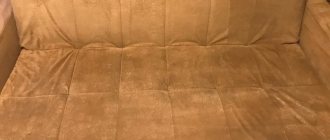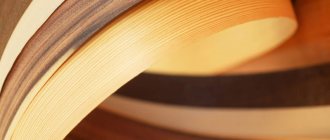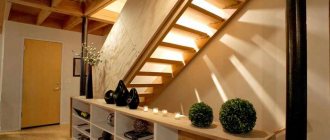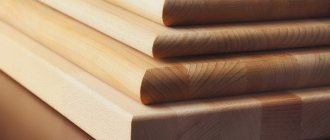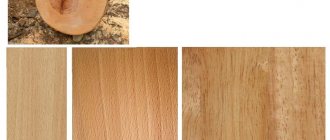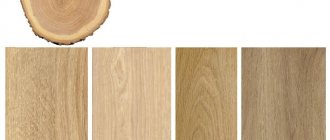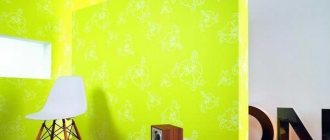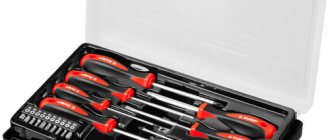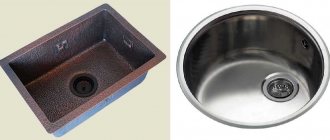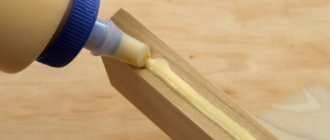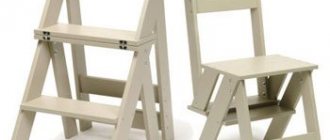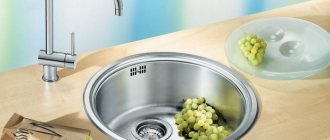- Home /
- Articles /
- Wooden stairs
- / Which wood is the best for a staircase: comparing the characteristics of oak, beech and ash
Choosing a staircase is a difficult task that requires a competent approach. Not only the design itself deserves attention, but also the material from which it will be made. In their quest for a healthy lifestyle, people are increasingly choosing natural wood, but in this case it is necessary to know that each type of wood has not only advantages, but also disadvantages. What is worth knowing about such common varieties as oak, beech and ash, how do these common types of wood differ, and which wood is best for a staircase?
Characteristics of oak stairs
The wood of this tree is an excellent material for construction and making crafts. It is highly reliable and durable. Properly processed oak boards are resistant to rotting and, after special treatment, are used for installation in rooms with any level of humidity.
Texture
Oak boards are characterized by a large texture with clearly defined annual layers, heart-shaped rays resembling flames, with dark strokes. The wood of young trees has a grayish-brown tint, but changes with age and becomes yellowish-brown.
The sapwood of oak is quite thick, it has less strength and hardness. The properties of wood are largely determined by growing conditions. The texture and color of wood varies, this allows you to satisfy the taste of any customer.
Advantages and disadvantages
A staircase made from high-quality oak boards will last for centuries.
Positive aspects of an oak staircase:
- durability;
- strength;
- wear resistance;
- high aesthetic qualities;
- the ability to create a structure of any shape.
The main disadvantage of oak stairs is the high cost of the material. Regular treatment of the stairs with protective compounds will be necessary, but this requirement applies to any type of wood.
Beech
Density 660 kg/m3.
Beech is the second most common and valuable genus of the beech family after oak. These are deciduous trees, slender, columnar, 45-50 m high, with a trunk diameter of up to 2 m. Beeches grow up to 350 years, most intensively at the age of 40-100 years. Life expectancy is over 500 years.
Beech wood is white with a yellowish or reddish tint. The annual layers are clearly visible. Old trees sometimes have red-brown colored mature wood. This does not affect the quality; on the contrary, such trees are especially valued by cabinetmakers, but they are quite rare. The color range of beech wood is quite diverse - from pink to white. To remove this variety of colors and give the wood a more uniform shade, as well as make it more stable, beech requires preliminary steaming. If this is not done, the texture of the wood will be very variegated. This procedure takes about three days.
Beech has perhaps the highest bending ability, which was widely used in the production of bent furniture. The wood is well processed, perfectly finished, and accepts various paints and varnishes.
Due to its high wear resistance, beech is widely used for the manufacture of wooden stairs. The pleasant warm shade is the reason that it is often used for separate small items.
The light pinkish tint of beech evokes a feeling of warmth. The simple and noble structure of this coating is the perfect finishing touch to any interior.
BIRCH
The density of wood is 650 kg/m3.
Birch got its name from its white bark. This is a non-nuclear breed. The wood is white, with a yellowish or reddish tint. The annual layers are poorly visible. The medullary rays are visible only in strictly radial sections.
The distribution area of birch is very wide - 2/3 of the area of all deciduous forests in our country.
Birch is used for the manufacture of plywood and wood panels, furniture, equipment, fittings, turning products, and veneer. Birch wood is perfectly tinted, opening up almost unlimited design possibilities.
Ash staircase
An ash staircase will be cheaper, but this will have a slight impact on its technological characteristics and appearance. Ash wood is hard, elastic, wear-resistant, beautiful.
Texture
The texture of ash wood is similar to oak. On any section, growth rings are clearly visible. The core of the ash tree is light in color, the sapwood is wide, yellowish-white. The wood is light, pronounced medullary rays are practically absent, they are visible only with a clear radial section as small shiny lines and dots. The tree has a beautiful yellowish color.
Advantages and disadvantages
Ash wood is ideal for making stairs.
She has the following positive qualities:
- strength;
- flexibility, plasticity;
- high impact strength;
- ease of processing and grinding;
- variety of shades, beautiful pattern of growth rings.
Disadvantages include susceptibility to rot and pest damage. It is necessary to take into account the humidity of the room in which the stairs will be installed. Regular impregnation with protective compounds will increase the durability of the structure.
Why choose C3 technology
C3 technology for cladding concrete stairs was developed and patented by specialists. The main advantage of the products, and we are talking about monolithic overlays and facing slabs and ready-made flights of stairs, is the high strength of M1200. In this indicator, C3 stairs can only compete with granite structures.
Good resistance to aggressive moisture, resistance to mechanical damage and high frost resistance of F500 are also valued, which means that the stairs can withstand 500 freeze-thaw cycles without loss of properties. If you look closely at the photo, you will notice the presence of a relief pattern, thanks to the presence of which the steps and platforms not only look visually attractive, but also do not slip. This is also highly appreciated by customers, especially when it comes to installing the entrance group of common areas with high traffic.
Manufacturing of stairs
Our company will produce a wooden staircase of any size and design according to your order.
Below are approximate prices for the production of an open staircase with a flight width of 1000 mm, having 5 rises 1 m high, made of oak and ash.
| Type of stairs | Price of oak stairs, rub. | Price of ash stairs, rub. |
| Straight | 170000 | 155000 |
| L-shaped with winder steps | 275000 | 245000 |
| L-shaped with platform | 270000 | 255000 |
| U-shaped with winder steps | 300000 | 285000 |
| U-shaped with platform | 320000 | 305000 |
| Goose step | 150000 | 135000 |
| Circular | 250000 | 235000 |
| Stair cladding made of a different material | 170000 | 155000 |
Spruce
The average density of spruce wood at a standard humidity of 12% is 445 kg/m3.
The total area of spruce forests in Russia is about 70 million hectares. Spruce lives 250-300 years.
The spruce wood is white, with a slight yellowish tint, and low in resin. Spruce is a low-density species. In terms of strength properties it is somewhat inferior to pine. It bends somewhat better than pine wood.
Spruce is a tree that is exceptional in its properties. One of these properties is musicality. Since ancient times, I have been making musical instruments from spruce, including stringed instruments. Novgorod harps of medieval Rus' were most often made from spruce. The wood is soft, light, and is used as a building material (boards, beams), for small crafts, and for processing into wood pulp. Used for the production of wood chemical products - paper, cardboard, cellulose. It is also used in ornamental gardening and park construction.
conclusions
The reliability, durability, and appearance of the staircase depend on the choice of material. Both oak and ash are hardwoods that are highly durable and wear-resistant. The oak structure is particularly durable; even when used in unfavorable conditions, the staircase will serve you for decades. If you take care of it in a timely manner, it will last for hundreds of years. Ash stairs are not as durable, but they are a budget option. If you are not limited in funds, then choose oak. This staircase will emphasize your wealth and good taste.
Pine
Pine density is 520 kg/m3.
Pine is distributed throughout northern Russia and most of Siberia and forms both pure forests and forests mixed with spruce and other trees.
Pine lives up to 600 years and in adulthood reaches a height of 30-40 m. Its trunk is straight, even, and easy to plan and saw. Pine wood is sound, resinous, and low-elastic. Depending on the characteristics of the growing conditions of the tree, the density and specific gravity of the wood may vary. Scots pine is distinguished by wide sapwood, which cannot be removed. Therefore, in warm weather and the sapwood thickening, which occurs from spring to autumn, the log may turn blue. Surface blueness can be observed even in well-ventilated wood piles. Blue stain does not change the mechanical properties of wood, so it can be successfully combated. For these purposes, the industry produces a number of drugs.
Pine wood is soft and easy to work with, and does not crack when dry. Thanks to its beautiful color and clearly defined texture, it is widely used in the production of carpentry, in the production of artistic carvings and turning products.
Laying
We should immediately note the undoubted advantage of this material. Laying parquet boards with your own hands is much easier than parquet. This work is a bit like installing laminate, but there are still certain differences.
There are two common installation methods - glued and glueless. Each of these methods involves the use of a different board design. The first option is traditional, although it is gradually becoming a thing of the past. It is being pushed aside by the glueless method. The reason for its popularity is obvious - installation is simple and does not require special skills.
The parquet boards must be placed in the direction the light falls. This will make the joints between the boards almost invisible. It can be laid parallel to the wall or at an angle to it. It depends only on your desire.
First, form the first row, first leaving a gap of one and a half centimeters between the wall and the board. When forming the second row, slightly shift it in relation to the first. This will significantly increase the strength of the floor. The offset is usually made by half the board. In other words, if you start the first row with a whole board, then you need to start the next row with a half. This rule must be observed throughout the entire installation. And it is important not to forget about the gap at the wall.
After installation is completed, the baseboard should be installed. It should be fixed to the wall so that it does not interfere with thermal deformation of the floor.
What is a furniture panel
To understand the choice of a tabletop made of solid wood, you need to understand that in industrial production, tabletops are not hollowed out from a solid tree trunk. Although we look at the photo for an example of such a tabletop. Solid wood countertops are made from furniture panels.
A furniture panel is a structure glued together from natural wooden slats using various technological methods.
A shield glued together from solid wide boards is called one-piece lamella . Lamella is a term applied to plates.
A board made from joined wide boards is called a finger-jointed board with a closed mini-tenon.
A board glued together from narrow joined boards is called a face-glued board.
As you can see from their drawings of panel designs, the best option for a tabletop would be a panel with a minimum number of joints, that is, a solid lamella panel.
Advantages of parquet boards
It would be unfair not to talk about the shortcomings that parquet boards have (as, indeed, any finishing material). Customer reviews indicate that this coating requires strict adherence to humidity and temperature conditions in order for the board to maintain its appearance and original shape. In addition, many (especially ladies) note that it is undesirable to walk on such a floor in stiletto heels, as the varnish coating can be damaged.
Although we said above that parquet boards do not require special care, reviews from owners of such floors sound somewhat different: in fact, to care for this floor, special compounds, mastics, and stain removers are required, as for caring for piece parquet.
Single-strip parquet board
If you have already looked closely at this material in a store, you probably noticed that the price tag or product description states: “Single-strip parquet board.” What does this indicator mean?
A single-strip board imitates an array of boards. Typically its width is from 180 to 210 mm. There are also narrower options, but less frequently. This board looks very respectable. Its top layer is covered with monolithic veneer of valuable wood. In addition, the production of such material is a very labor-intensive process. Because of this, the cost of such a board is much higher. However, if you compare it with a solid wood board, it will cost you almost twice as much, but it will look no worse, and in terms of technical characteristics it will even surpass it.
A two-strip board imitates piece parquet (large format). Its width is from 85 to 100 mm. It should be noted that in this case, the parquet board will undoubtedly win in price.
Three-strip boards are also an alternative to block parquet. It comes with a factory applied topcoat. The prices for such a board are very affordable, since its production is not too expensive.
What is the strongest tree in the world?
Of the coniferous timber, the hardest is larch. Its hardness is 2.6 points on the Brinell scale. The wood has a dark red core.
Interesting materials:
How to disable forwarding on Xiaomi phone? How to turn off the assistant on your phone? How to disable Wi-Fi distribution on your phone? How to disable high contrast mode on your phone? How to disconnect Sberbank online from your phone? How to disable synchronization between your phone and computer? How to disable sleep mode on Xiaomi phone? How to disable Beeline TV tariff on your phone? How to turn off your phone without a power button? How to turn off Galaxy A50 phone?
Which parquet board is better
Choosing a good parquet board is not easy. This is primarily due to the huge range of these products in our stores.
The best hardwood flooring can be made by the best manufacturer. Famous companies value their reputation too much to allow themselves to produce low-quality products.
It is important to pay attention to the quality of the locks - the quality of installation depends on this. Today the following companies have proven themselves to be excellent on the Russian market:
- When buying a parquet board, run your finger along its edge. It should be perfectly smooth and even.
- Don't forget about the size of your room. A light floor will expand it, and a dark floor will make the living room more comfortable.
If you still have doubts about which flooring material to choose, then think about the environmental friendliness of the material. Then your last doubts will disappear, and you will prefer parquet boards.
An important element of any interior is the floor. Both the aesthetics and convenience, as well as the coziness and comfort of the room, depend on the type of flooring. Modern manufacturers offer a wide range of flooring: linoleum, carpet, laminate, tiles, porcelain stoneware, parquet, solid or parquet boards. Parquet flooring, as the most prestigious and attractive, is widely popular due to its excellent aesthetic qualities and high performance characteristics. In addition, it is an indicator of excellent taste, solidity and prosperity of the owner of the house. The most common flooring option is ash or oak parquet boards. To give preference to one of them, you should study the qualities of the wood and compare them.
How to care for wooden utensils
- Hot water and soapy water will help remove the smell and food residues. Apply it to a sponge and wipe the dishes with it, then rinse the product with water.
- Remember that you cannot wash wooden items in the dishwasher, or use chemicals such as washing powders or gels to clean them.
- To get rid of bacteria and odors, wipe your dishes with alcohol once a month.
- If the product has darkened or been stained by vegetable juice, hydrogen peroxide will help restore the color. Soak a soft cloth in the solution, wipe the dishes and leave them for 15 minutes. Then rinse with water.
- Wooden items should be stored vertically and away from sources of moisture and heat, such as radiators and stoves.
- If mold appears on the surface, vinegar will help. Dilute 2 spoons in warm water and wipe the dishes. Then wash it with warm soapy water.
- Once a month, wipe the dishes with a special oil for wood care. The product will preserve the appearance of the product and also protect it from drying out and waterlogging. The oil has a natural composition and is safe for health.
